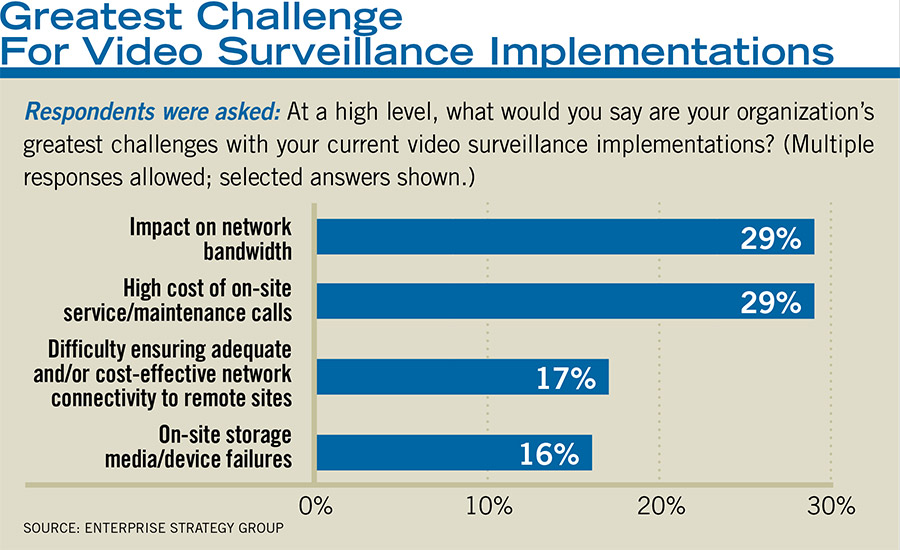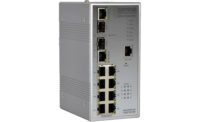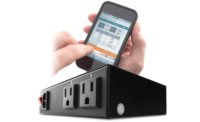Rapid change has been a constant within the industry for the past few years, and change remains a main part of “business as usual” for security professionals and end users alike. Of the many changes, the most prevalent has been the continued evolution of networked products and systems, with more and more end users migrating from analog to IP-based video, access control and other systems.
The increased integration between security and non-security systems makes up a second main category where advancements have significantly contributed to wholesale industry-wide change. As a greater number and wider variety of products incorporate network capability, integrated systems become even more important in providing the data and information necessary to improve security using predictive analysis, for example, which can help detect incidents before they can occur. The addition of non-security systems and devices to the mix means that in addition to strengthening security, intelligence can also be applied to business processes, allowing end users to streamline and maximize the effectiveness and efficiency of marketing, merchandising, staffing levels, operational procedures and more. This is the promise of the Internet of Things, which the industry has been talking a great deal about lately.
If we’ve learned anything from this growing and expanding phenomenon, it’s that virtually anything either is or could potentially be connected to a network. The data each of these devices create must be moved from point A (the device itself) to point B (the headend) and even points C, D, E and beyond (other devices and systems with which information is shared). Needless to say, this leads to more traffic to be transported over networks, some of which are already feeling the strain in terms of available bandwidth.
Video and images generated by surveillance systems just might be the biggest culprit in terms of eating up precious bandwidth. With image quality increasing, is there no end in sight?
Some of these concerns have been addressed with compression codecs, most notably H.264, which reduces file sizes to make them more manageable for transmission across networks. The emerging H.265 codec should be even more helpful in this area, promising as much as 50 percent greater efficiency over H.264, although what the actual numbers may end up being remains to be seen, as only a handful of manufacturers have begun to trickle out H.265-enabled offerings.
“All the high-res video formats — HD, megapixel, 4K — require high bandwidth. That’s why you see more switches, media converters and the different media focusing on Gigabit (Gbps) capabilities,” says Frank “Skip” Haight, vice president of marketing for Danbury, Conn.-based Communication Networks (ComNet). “The more high-resolution video being used, the bigger the pipe needs to be, per se. In many applications, managing the data flow becomes paramount. A bigger focus is network management, thus the need to increase the use of managed switches along the network.”
Without a doubt, transmission plays a major role in today’s video systems. And while compression advances are helping, there has been little movement on the physical side of the equation, Haight says. “There are really no new types of transmission occurring; it’s still over copper — UTP or coax, fiber optic or wireless,” he adds.
The most common media in use today remain fiber, wireless or radio, and copper — Cat5/5e/6 or coax. All have their specific benefits, with fiber offering advantages in bandwidth, distance and immunity. Copper remains important in allowing greater transmission distance, and wireless radio Ethernet is becoming more practical and useful, Haight says. This is especially true for applications where trenching or pulling new cable would be cost-prohibitive. A number of wireless products on the market are designed not only to be easy to set up and use, but also offer throughput of up to 500 megabytes per second (Mbps) and are able to operate conservatively at distances of up to two miles.
For the time being, and well into the future, he adds, these will remain the choices integrators have when designing system infrastructures.
“Looking forward, I don’t believe there will be a new transmission medium invented, but what can be done over these different media is certainly going to advance,” he says.
These new capabilities include greater power over Ethernet (PoE) distances and power over copper media; greater distances with less chance of interference from wireless; and greater bandwidth over distance with fiber. With more high-definition, high-bandwidth video being used, 10 gigabytes per second (Gbps) networks are becoming more common, and switches with 10 Gigabit uplink ports are the next step up in the demand for bandwidth.
“Today’s HD, 4K and high-resolution formats are creating the demand to transmit this vast amount of IP data; transmission product manufacturers are going to have to keep up,” Haight says. “Managed switches that have gigabit ports with a 10Gbps uplink will become in higher demand as systems turn to using many HD IP cameras in a security video network.”
Where the Action Is
The increased need for power to ensure that these devices and systems are continually operating is equally as important. Maintaining safety and security of people, facilities and assets is a critical function, but no matter how advanced technologies and solutions become, their effectiveness is nullified without a reliable and consistent power supply.
“Thankfully, network communications capabilities have extended to core power and transmission components to help address the risk of system interruption,” says Ronnie Pennington, national sales engineer for Altronix, based in Brooklyn, N.Y.
Not surprisingly in the age of the Internet of Things, foundational solutions that have traditionally been considered simply part of system infrastructure now incorporate network capabilities.
“With network communications added to core power and transmission components, systems designers and installers can now achieve higher levels of system integration,” Pennington says. “And with APIs (application program interface) available for customization with partnered suppliers, this new technology opens up a whole new realm of possibilities.”
Power Over Ethernet
With this in mind, it’s easy to see why power is where most of the action is these days. One example is the use of PoE, which has spurred development of devices capable of receiving power over Ethernet. Today’s PoE comes in a variety of flavors, all defined by specific IEEE802.3 standards, to accommodate the increasing power demands of video system components. PoE supplies 15.4 watts of power; PoE+ provides 25.5 watts; and the latest entrant, PoE++, delivers up to 77 watts. The promise of Ethernet and the IEEE802.3 standards has always been the idea of total interoperability between products that meet those standards, which may be easier said than done, Haight says.
“The reality is that things do not always operate as promised. A concern facing integrators and dealers at the point of installation and testing is that all devices on the network do not operate in harmony,” he says. “PoE is a great way of powering remote IP devices, but there are many variables that affect PoE delivery. Factors such as distance, quality of Cat or coax cables, connections all can have an effect.”
The potentially enormous costs of migrating end users from analog to IP have made “rip-and-replace” — long viewed as the only way to accomplish the objectives — a dirty word. Thankfully, Haight says, the concept can also be considered obsolete.
“One of the challenges integrators face with so many companies choosing to make the wholesale migration from analog to IP is to use existing infrastructure that is in place where possible — think of the miles of installed coax and UTP cables — and trying to do it in a cost-effective way; using the installed coax and UTP media works well,” he says.
Many years ago, manufacturers saw an opportunity for adaptive transmission technologies like Ethernet over coax (EoC), which allowed users to upgrade their coax infrastructure for networked systems. By providing installers with the ability to deploy hybrid devices and systems cost-effectively, EoC hardware enabled the coexistence and capitalization of existing and new cabling, which in turn expanded the potential system configurations for integrators, Pennington says.
Because no two existing or new installations are identical, integrators need multiple choices to help customers make the switch to IP without requiring a completely new infrastructure. This is precisely why manufacturers have developed solutions that allow integrators to take advantage of PoE functionality beyond Ethernet by using coax and even fiber infrastructures.
“Although you can’t transmit electricity over optical fiber, you can place a fiber optic media converter or switch at one remote location with power and send power to remote cameras a good distance away,” Haight says. “You get the bandwidth benefit of fiber, allowing longer data runs back to the headend, and the device can be a PSE (power sourcing equipment) in the field.”
While most of the existing Ethernet over coax and UTP products have the ability to pass power through from PoE switch or midspan switch, one potential hurdle is distance, Haight says.
“The electrical resistance of an electrical conductor is the opposition to the passage of an electric current through that conductor. Without overcomplicating this discussion, the greater the physical distance, the greater the difference is between the voltage applied at one end and received at the other end,” he says. “Given the transmission distances of the cable, many times the power supplying equipment cannot pass through enough power to operate the equipment at the remote end.”
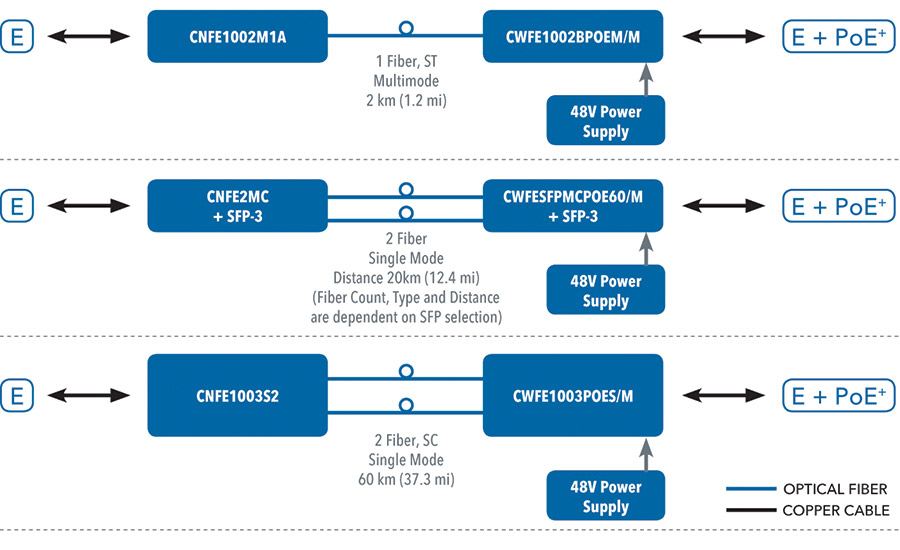
There are a number of pass-through products available to alleviate PoE distance challenges. For example, ComNet offers a solution that can act as power sourcing equipment and provide up to 30 watts at distances of more than 100 meters. Lower voltages can be sent even farther, as much as 600 meters with 100 Mbps throughput.
“This capability alone gives the integrator an untold amount of flexibility and has the potential to reduce a very significant amount of cost from any project in terms of material cost and installation labor,” Haight says.
It’s rare that any single project or application can be completed using a single medium, Haight says; and there’s a high probability that fiber optics, existing copper and even wireless will be needed.
“An integrator or dealer is going to have to be comfortable with all media and able to design a network that accomplishes everything the end user requires, and that might require a combination of fiber, copper and wireless,” he says. “Partnering with a company that can provide all types, is competent in helping design and who can make sure everything works beforehand gives them an unmeasurable advantage.”
The Effect of Mobile
Mobile is definitely a buzzword, but as Skip Haight of ComNet says, mobile is just another method of IP data transmission and viewing. However, mobile may hold even greater significance for video applications one day.
“Going forward, using cellular data transmission is going to be something to be considered, and there are products being introduced today,” he says. “As cellular data networks evolve — LTE and beyond — cellular data transmission will also continue to evolve especially in applications that move, such as buses, trains, cars and trucks.”
Among the solutions on the market are ComNet’s two new managed Ethernet switches, which provide users with the option to use cellular data backup transmission. In the event that there is a network failure, the switches automatically connect to an Internet network using a mobile carrier such as AT&T or Verizon.
Business Opportunities
Obviously, the vast amounts of data that systems generate are useful in both security and overall business and operations, but this data can also create opportunities for integrators.
With remote system monitoring capability and EoC/UTP and other technologies, end users benefit from managed services that can help simplify and reduce investment in physical security systems. The fixed monthly cost associated with this service, combined with 24/7, real-time monitoring for mission-critical applications just makes sense, says Ronnie Pennington of Altronix.
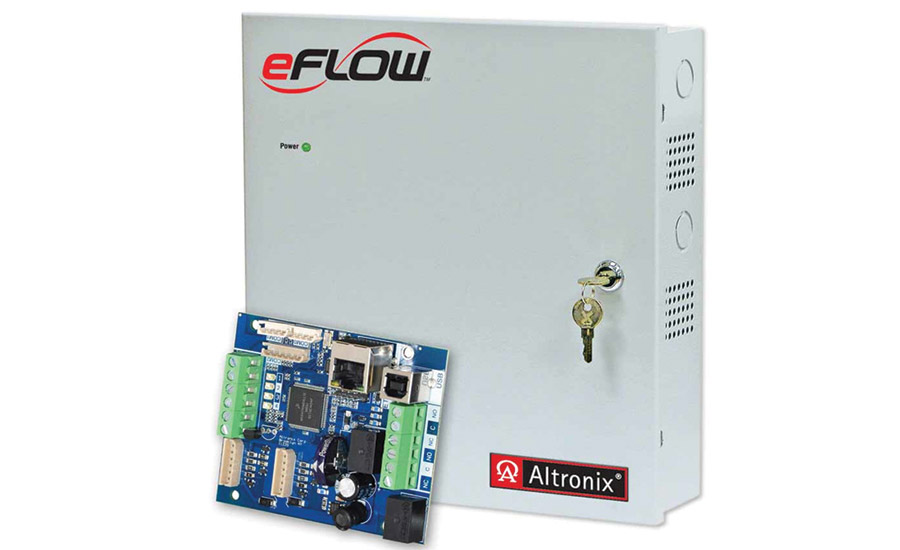
“Another benefit of managed services is that they can augment a company’s technical resources, allowing the organization to focus on supporting its critical business functions. This can be particularly beneficial in an enterprise environment with remote branch locations,” he says.
Power management solutions can ensure the overall health of a system by remotely monitoring, controlling and reporting diagnostics in real time from power supplies and peripheral components. Monitoring might include critical operation criteria such as AC presence, battery status and health, voltage output, current load, ambient temperature and more. End users benefit from knowing that their systems’ integrity, stability and operation are being professionally monitored and maintained, resulting in higher overall security and reduced liabilities associated with downtime. Integrators can receive notification of potential issues that provides the information they need to quickly address or even prevent potential issues or problems.
“The goal is to have service technicians spend as little time as necessary in the field. The information provided by a networked power management solution significantly assists in achieving this goal,” Pennington says. “Often a simple solution, such as remotely rebooting a device, can resolve an issue. Should a service call be required, the diagnostic information that networked power management solutions provide can pinpoint the exact source and location of the issue. This allows technicians to arrive on site with the parts and tools they need for fast, efficient resolution.”
Under a traditional preventative maintenance contract, dealers and integrators provide regularly scheduled maintenance to replace batteries, clean camera domes and lenses, inspect panel wiring, etc. Adding power monitoring allows these contracts to be expanded with additional services and assurances at higher fees, providing end users with peace of mind while generating additional recurring monthly revenue (RMR) for the integrator.
Those customers who opt for a pay-as-you-go service model rather than a service contract are often charged a minimum fee for any site visit. Remotely monitoring powered devices and systems allows integrators to quickly diagnose and even fix or prevent failures without sending a technician on site. For example, if a servicing dealer charges a two-hour minimum for a service call and the remote diagnostics allows a technician to spend less than an hour fixing the problem, the end user will be glad that the system repair was made quickly, and the servicing dealers realized a higher profit from the service call as a result of more efficient time and resource management.
“Managed power is an essential element in a comprehensive security solution and its continued evolution helps ensure the operational integrity of today’s integrated systems,” Pennington says.



